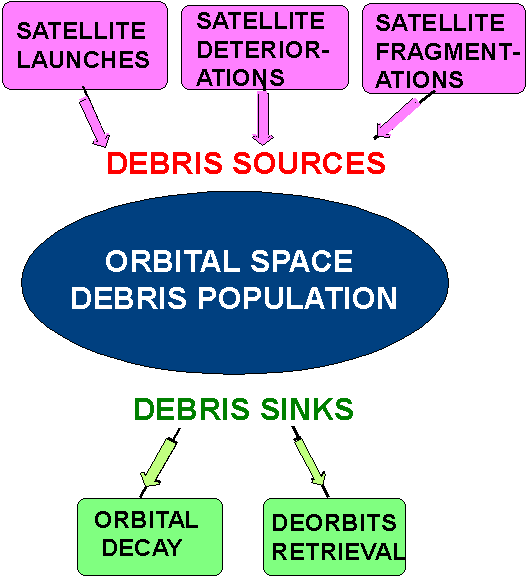Overview of Orbital Space Debris
It used to be thought that space was a very large and limitless place, and indeed it is, but those areas of space in which man has been orbiting satellites for over 40 years are now becoming crowded. Crowded not so much with useful satellites, but crowded with non-functional satellites, final stage launch rocket bodies, and with multitudes of smaller objects that have resulted from numerous satellite deteriorations and fragmentations. Collectively, this material is now referred to as Orbital Space Debris. It is supplemented by natural space debris (ie meteoroids) that also passes through Earth orbit.
The smaller pieces of orbital space debris now exceed the population of meteoroids in Earth orbit and are becoming an increasing threat to orbiting spacecraft. The larger the spacecraft and the longer it stays in orbit, the greater is the chance that it will be hit by a piece of orbital space debris.
The diagram below indicates the sources and sinks that cause changes in the orbital space debris population.

The initial and continuing source of space debris is the launch of satellites. Not only the satellites themselves add to the population of orbiting space objects, but often the last stages of the rockets that are used to place them in orbit also remain aloft for many years.
As satellites get old they deteriorate under the influence of the space environment. Outgassing can not only release gases, but may also take other materials with them, as the gas beneath a surface slowly makes it way into the surrounding environment. The strong solar UV in space can cause the deterioration of many materials. Paint and other surface materials may be expelled in flakes.
More catastrophic than age related deterioration are satellite fragmentation events. These may result from collisions with other (external) objects, or they may be explosive, as when remnant fuel in an old spacecraft undergoes an exothermic reaction (ignites). Both of these type of events can produce an astounding number of small fragments that become a new source of space debris.
On the debit side, the removal of orbiting space debris may be due to a deliberate action or the result of natural orbital decay. In low Earth orbits, a satellite is subject to atmospheric drag, and this will eventually cause it to re-enter the Earth's atmosphere. Unless the object is particularly large, it will completely ablate during this process, and there will be no visible remnant that reaches the ground. If the object is felt to pose a threat to life and infrastructure on the ground, then it is sometimes possible to cause a controlled re-entry with a fuelled de-orbit burn. Other spacecraft, may sometimes be directed to retrieve an ageing spacecraft of particular significance. In the past this has been only for satellite refurbishment, but in the future it might be due to environmental concerns.
Orbital space debris is of increasing concern to all space agencies around the world, and is becoming the subject of legal discussions. The areas of concern are:
- Monitoring the orbital space debris environment
- Satellite design to minimise orbital space debris
- Satellite operations to minimise orbital space debris
- Modelling of orbital space debris and its effects
- Hypervelocity facilities to measure debris impact effects
- Satellite design to minimise the effects of space debris impacts
- Consideration of active measures to reduce space debris
- Legal implications of orbital space debris
Space tracking stations around the world can detect space debris down to the centimetre level. Long duration exposure experiments in space can inform us about the space debris population of micron size. Ground meteor radars are currently being investigated to determine whether they can provide useful information on the debris population of intermediate size (the peri-millimetre scale).
Material prepared by John Kennewell





